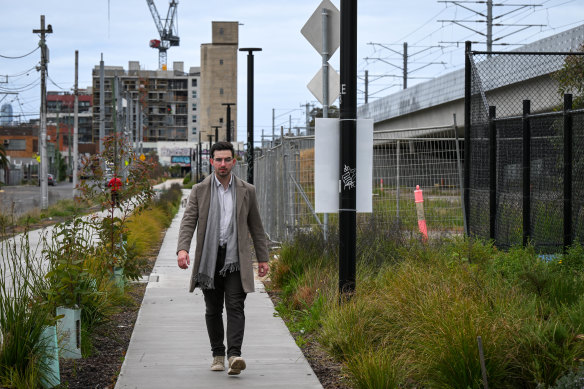Save articles for later
Add articles to your saved list and come back to them any time.
Key points
- YIMBY Melbourne wants to see six-storey developments within one kilometre of train stations and 500 metres of tram stops.
- YIMBY Melbourne’s “missing middle” report estimates this will deliver more than 5 million new dwellings in places where people want to live.
- The report recommends rezoning all low-density neighbourhood residential land to higher-density zones.
Housing activism group YIMBY Melbourne is calling for the development of Melbourne’s “missing middle” by enabling six-storey, mixed-use development on all residential land near train and tram stops.
The Yes In My Back Yard movement, which launched earlier this year, has released a report calling for changes to Victoria’s planning and tax systems to enable streetscapes similar to those in Paris across inner urban Melbourne.
Jonathan O’Brien of YIMBY Melbourne at the Moreland station, where the group is proposing redevelopment.Credit: Eddie Jim
YIMBY Melbourne, which has gained traction as a counterpoint to residents who oppose new developments in their local areas, wants to see the six-storey developments within one kilometre of train stations and 500 metres of tram stops.
The report estimates this could deliver more than 5 million new dwellings in places where people want to live.
YIMBY Melbourne leader Jonathan O’Brien said Melburnians wanted to move beyond clusters of skyscrapers surrounded by multimillion-dollar cottages.
“The missing middle is what doesn’t exist in Melbourne between a dichotomy of towers, tall builds, the things that people think of when they think of development, and the urban carpet of detached homes, single family homes. The missing middle is really all the space, the diversity of housing that exists between those two points,” O’Brien said.
“We can have Paris’ streets, Amsterdam’s bikes, and Berlin’s vibes right here in Melbourne, so long as we embrace key parts of their iconic urban designs.”
YIMBY Melbourne’s report recommends rezoning all low-density neighbourhood residential land in Melbourne to higher-density zones, and making development within the zone by-right in exchange for one in 10 homes being transferred to a public or community housing provider.
The report also calls for abolishing the first home owner grant and replacing stamp duty with a broad-based land tax.
It recommends incentives for landowners and governments to consolidate blocks and using newly consolidated lots to create larger inner urban parks surrounded by larger development blocks.
The report advocates reassessing all heritage, neighbourhood character and design overlays within the missing middle zone areas and abolishing the overlays where an assessment indicates that the negative social impacts of the overlay are greater than its benefit.
O’Brien said he knew this recommendation would be controversial, but added that so much available land in Melbourne was covered by heritage overlays.
“We’re pretty bullish on the removal of overlays, but that doesn’t mean the end of heritage,” he said.
O’Brien said heritage should be assessed on a site-by-site basis. Alternatively, if the government thought a building’s heritage was worth protecting, it should plan to bring the building into public ownership, he said.
O’Brien said the government’s housing statement, released last month, was not comprehensive and did not address the missing middle, focusing instead on large-scale developments and granny flats.
“Of course, it didn’t go far enough in terms of what we’re pushing for, which is housing abundance,” he said. “We see the missing middle as a natural fit.”
Planner Colleen Peterson, of Ratio Consultants, said YIMBY Melbourne was doing a great job of trying to speak for future generations and people not involved in the planning process.
“It proposes some pretty radical ideas. Some of them are really quite inventive, but perhaps not that practical,” she said.
Peterson said the concept of increasing height limits within proximity to fixed rail services was “pretty solid” and had been supported in planning before, but not implemented by local councils.
However, she said while six-storey buildings may be practical directly along tram and rail routes, it was more difficult to apply those heights to the properties behind them, as Melbourne did not have the same block sizes as cities like Paris.
Peterson said that even limiting the increase in height to properties adjoining tram and rail routes would provide hundreds of thousands, if not millions of homes.
“I applaud left-of-centre, outrageous thinking, because we are going to need a fresh approach to solving the housing crisis,” she said.
A spokesman for the government declined to comment on the YIMBY Melbourne proposals, but said work being done as part of the government’s housing statement would result in 800,000 new homes being built over the next decade.
“Our bold planning reforms will boost housing supply, ensuring good decisions are made faster, and give industry greater certainty with a planning system that works for Victorians – not against them,” he said.
The Morning Edition newsletter is our guide to the day’s most important and interesting stories, analysis and insights. Sign up here.
Most Viewed in National
From our partners
Source: Read Full Article



